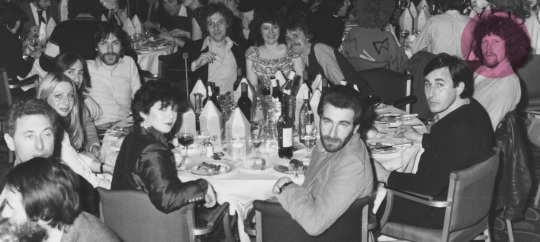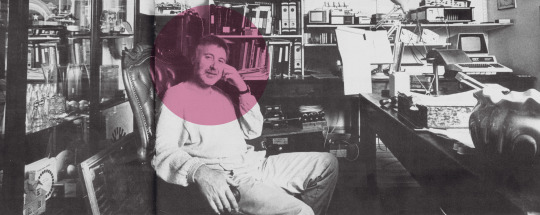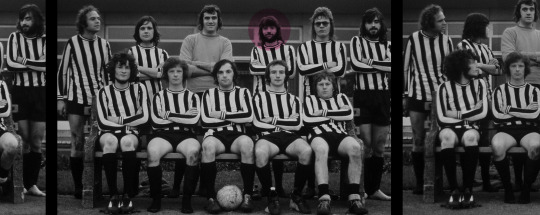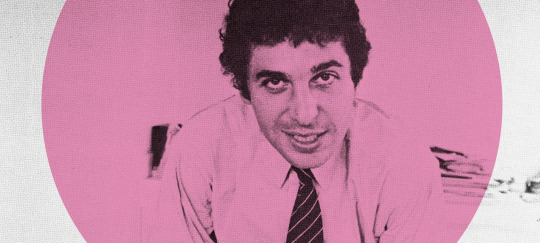#Collett Dickenson Pearce
Text
BLOG/CAST: Graham Watson #1
In the style-obsessed 80s, no agency was more obsessed than BBH.
Everything that came out of the place reeked of it.
Including the staff.
Their men’s toilets were stocked with tubs of hair gel (What? It was the eighties!)
Their AAR reel, a tool for agencies for clients to compile pitch lists, didn’t follow the template the rest of the industry did (pasty faced public schoolboys using big words,…

View On WordPress
#Adrian Flowers#Alan Parker#Audi#Audi Germans ad#B&H ads#Barbara Nokes#Barclays ad#Barney Edwards#Barry Kinsman#Bartle Bogle Hegarty#BBH#Benson & Hedges ad#Boddingtons#Bruce Crouch#CDP#Chris Herring#Collett Dickenson Pearce#Derek Guyler#Duffy#Eric Sykes#Ford Ad#Garland-Compton#Hamlet ad#Ian Green#John Hegarty#John O&039;Donnell#Lego &039;Kipper&039;#Lego ad#Location#Location - Graham Watson
0 notes
Link
Heineken Campaign (1970s)
Copywriter Terry Lovelock was asked to develop a new campaign for Heineken in the UK. The brief consisted of one word: Refreshment. From this, he created the famous tagline ‘Heineken Refreshes the Parts Other Beers Cannot Reach’. The advert ran over the course of 22 years in different variations.
Researching past Heineken Campaigns allows us to get a feel for the brand's tone of voice and the key messages they wish to convey to their audience. With the word ‘fresh’ repeated throughout the brief, this still forms a large part of Heineken's brand identity today.
- Jenny
0 notes
Text
The forgotten hero of british adland
When you paintings in marketing you hear a lot of the same names celebrated. Names like david ogilvy, bill bernbach, trevor beattie and john hegarty. Then every so often a reappraisal of the history of advertising is achieved and new vintage name is dug up and celebrated… such as the socrates of san francisco, howard gossage. So, for these days’s blog post we concept we’d get in on the act and inspire a reappraisal of the paintings Digital Marketing Agencies in Stafford of one of advertising and marketing’s misplaced greats. A call now not cited hardly at all any extra, however who, for 2 many years, converted advertising thru the 60s and 70s as creative director at collett dickenson pearce, which held such customers as heineken, harvey’s bristol cream, fowl’s eye, hovis, benson & hedges and hamlet cigars. Oh and if that’s now not enough to top your hobby in him, humans together with alan parker, frank lowe, brian duffy, ridley scott, charles saatchi… say they owe their careers to him (alan parker, frank lowe, david puttnam are the human beings in the photo that you can see in this submit). Colin charters millward, advertising govt: born hull, yorkshire 29 august 1924
Colin charters millward became born in sculcoates, which is at the outskirts of hull, in 1924, and studied at hull grammar college before then going to the leeds college of art. After serving in wwii, he gained a scholarship to the ecole des beaux-arts in paris, befre then heading to the ‘big smoke’ of london in which he joined the creative branch of the marketing company mather & crowther after which coleman prentis & varley, where he met john pearce, who went directly to co-located collett dickenson pearce, which millward then joined as creative director.
“Judgment… that changed into his talent. Actual readability of thoughts. You never felt he could be wrong, and had outstanding religion in him.”
Alan parker (sure the only who went directly to direct the high-quality mississippi burning)

to recognize millward’s impact, you have to realize that advertising within the nineteen sixties changed into quite horrible. Millward led the charge to deliver it up to the standards we see these days, the phrase “i suppose you observed that is ideal, do you?” ofetn heard resonating from his office at the fourth ground of cdp’s places of work in vital london. We’re probable at that factor wherein we should embed more than one the ads he turned into responsible for creating seeing that we’ve bigged him up so much, so right here you cross:
“Colin’s success became in setting all of our rubbish in which it belonged – inside the bin!”
Read Also:- “Domain name scam”, what is it, and how it works?
Sir frank lowe proprietor of lowe & companions global
millward made many trips to big apple where he was undoubtedly stimulated by using the work of bill bernbach and whilst he have become cd of cdp in 1960 he located creativity on the heart of company interest. One of the most well-known anecdotes of his tenure as cd involved an account guy who instructed him that harveys didn’t just like the organisation’s modern-day commercials. “well lad,” millward answered, “off you move lower back to bristol and tell them we do the commercials and that they make the sherry.”
In 1977 he end cdp over his disillusionment with advertising and by no means worked at every other advertising Digital Marketing Company in Stafford and marketing agency once more, rather he endured his love of portray… and via all bills he become a totally great painter too. Millward died in 2004 elderly 79 in london’s royal loose hospital.
Follow US:- Facebook, Twitter, LinkedIn , YouTube
0 notes
Photo

Hovis is bringing its iconic 1973 advert ‘The Bike Ride’ back to TV screens as the British breadmaker looks to stir up brand love among a new generation. The original collaboration between Hovis, creative agency Collett Dickenson Pearce (CDP) and director Sir Ridley Scott depicts an old man recalling his days as a baker’s boy struggling to push his bike up a cobbled hill. By mining the brand’s rich heritage CDP came up with the classic tagline: ‘Hovis: As good for you today as it has always been’. Now, 40 years since the ad first aired, ‘The Bike Ride’ (otherwise known as The Boy on the Bike) is returning to TV screens tonight (3 June). It uses footage remastered by the British Film Institute and a re-recording of the soundtrack – Antonín Dvorak’s New World Symphony – performed by descendants of the original Ashington Colliery brass band from 1973. Despite being four decades old, affection remains strong for ‘The Bike Ride’. Last year, it was crowned the nation’s favourite advert from the 1970s in an exclusive Marketing Week and YouGov Omnibus poll. Then, in May, the advert was named the most iconic of the past 60 years, according to research released by Kantar. Some 22% of the 1,200 UK consumers questioned said The Bike Ride was the most seminal ad of the past six decades, while a further 15% described it as the most emotional. “It puts into question, what’s been going on in the advertising industry for the last 40- plus years,” jokes current Hovis marketing director, Jeremy Gibson. Gibson believes a mix of nostalgia, a great creative concept and dedication to the craft have driven enduring affection for The Bike Ride over the past 40 years. Compared to the way ads are shot today, with multiple scenes and often aggressive price messaging, Gibson believes the advert stands out as something different. “Watching the original 45 seconds of that ad it’s almost a moment of pause and that’s why it has cut through as advertising has evolved and changed… because it becomes almost timeless and it’s a heart-warming thing to watch,” Gibson tells Marketing Week. “It celebrates a time in the advertising world when emotion and feel were much more important than ‘our phone is faster’ or ‘our product is cheaper’.” While the research highlighted an enduring love for the ad, Gibson explains it also felt like the right time to bring back The Bike Ride as it conveys a sense of there having been a healthier time as today’s society feels increasingly divided. READ MORE: How Hovis’s 1973 ad ‘The Bike Ride’ kickstarted its route to household name Going back in time Gibson is keen to show that Hovis is not just as a company with a nice ad but a brand with real depth and genuine history. To help tell this story, the re-release of The Bike Ride will be supported on social media with additional footage, including interviews with Hovis’s marketing director in the 1970s, Alan Hepburn, and director Sir Ridley Scott. Hepburn’s brief back in 1973 was to create an ad that would allow Hovis to tug at the audience’s heartstrings, rather than simply being obsessed by taking sales volumes from X to Y. “I asked Alan about how they wrote the brief back then compared to how we write it now and it was less around taking numbers, it was more about ‘we just want more consumers to love Hovis’. That’s a really simple brief but really hard to execute,” Gibson explains. “They absolutely hit the nail on the head with not just a great execution, but also a hell of a director who, from talking to Alan, took control on the day and told the client to just sit over there, which was fascinating to hear.” The filming of ‘The Bike Ride’ in 1973.Scott recalled the very end of the third day on location at Gold Hill in Shaftesbury, Dorset, when the clouds were coming in and all the equipment went back in the van. Then suddenly the sun came out and he told everyone to unpack for a re-shoot. Hepburn remembers that moment vividly as he was about to set off home in his car and suddenly there was a “palaver” as the team reset the entire shoot in order to capture the sunlight. Gibson marvels at the “level of love, care, passion” displayed by the brand, agency and director, which he believes comes through in the quality of the advert. This is the first time Hovis has revisited its Bike Ride roots since the 2008 campaign ‘Go on Lad’. The two-minute film follows a young boy running with a loaf of Hovis through history, from the sinking of the Titanic and World War I, to VE Day street parties, miners strikes and the Millennium celebrations. The advert ends with the classic line ‘As good today as it has always been’. Since then, Hovis has cut its range of pancakes, crumpets and muffins to focus on the quality of its core bread products. There is still growth to be had in the UK bread market, which in 2018 rose in value by 0.7% year on year to £3.5bn, according to Mintel figures. Pre-packaged bread represented 70% of the total volume sold. In September Hovis launched a new seeded batch, tapping into what Mintel describes as the trend for “bread with bits”, a category that contributed more than £30m to the sales of bread in 2017-2018. To support this clear focus on the core product, last year Hovis released ‘It’s Just Bread’, a campaign focused on bread as an everyday product. While the campaign did raise brand awareness, Gibson feels that, on reflection, the message was not as “pinpointed” as they would have liked. “We’re moving now into celebrating our product and our category, as opposed to making it a bit more every day. That’s what we’ll continue to do and using this Boy on the Bike relaunch as a bit of a springboard to do that,” he adds. Why an iconic ad can be a double-edged sword The advert itself, combined with the subsequent place it created for Hovis in the fabric of British culture, was the main reason Gibson wanted to join the bakery business as marketing director in December 2018. Excited about taking a brand with 130 years of heritage through its next stage, Gibson came on board at Hovis following two years as group head of marketing for Innocent Drinks. Prior to that he worked for three years as marketing director at PepsiCo, leading the juice and cereals teams, following five years at Molson Coors, which included a stint as global brand director. Having worked outside the Hovis business, he appreciates that an advert like The Bike Ride is a powerful asset for any brand and something other marketers would “break their arm for”. Speaking to Marketing Week last year, Alan Hepburn credited the The Bike Ride with kickstarting the baker’s transition into a household name. READ MORE: Sir Ridley Scott on why the 1970s was the ‘golden age’ of advertising Gibson accepts that working for a brand which such an iconic advert in its cannon can be a bit of a “double-edged sword”. “If you didn’t have it you’d wish you did and if you do have it you go, ‘how do you beat that?’. I’m sure the Cadbury ‘Gorilla’ team thought the same thing and the guys who came in after Guinness did their ‘Surfers’ ad thought, ‘right what do we do next?’. It’s really tricky one,” Gibson reflects. “My perspective is it’s about being true to the positioning of the brand and almost dissecting what The Boy on the Bike did and thinking, how do you take those elements and bring them to life?” Looking at the competitive set in a “dynamic” bread category characterised by own brands and big names vying for shelf space, Gibson hopes the re-release of The Bike Ride will appeal to loyal fans, as well as winning over new customers attracted to the brand’s identity as an authentic British baker. The post Hovis brings its iconic ‘The Bike Ride’ ad back to TV appeared first on Marketing Week.
0 notes
Text
Spotlight: Old Girl Gay Haines for International Women’s Day

Courage and integrity. These are the key tenets of Gay Haines’ philosophy on life and it is the mantra that has seen her career trajectory sky-rocket from a stay-at-home mum to leader of a global business empire – at that time the only female Chairman and CEO of a publicly quoted company - and voted one of The Sunday Times/Debretts 500 Most Influential Britons in 2016.
An Old Girl of Malvern Girls’ College, she returned to MSJ in February to talk to the girls about her three decades in business, first of all in London’s leading advertising agencies and then on to running blue-chip headhunting agencies, placing the most senior communications executives from America to Asia and Australia.
There is no doubt that she is a tour de force, exuding a palpable energy, warmth and ‘can do’ mentality that is totally infectious. “Anyone can do what I have done. I’m not a great intellect, nor strategist, but I know what I’m good at”. In her own words, “If you had told me, or my teachers at Malvern Girls’ College, that I would achieve half of what I have done, I think they would have laughed out loud!”
Following school, Gay’s life had followed a happy and predictable route for women of the time. She was married to John, a barrister, had three young children, and lots of friends in the same position. She saw her job as making sure her home ran efficiently, “that the children were fed and bathed by the time John got home, that dinner was on the table, and that he had a clean shirt for the morning”.
So what happened to change a happy and comfortable, but quite ordinary, life as a wife and mother, to someone who has established herself as one of the UK’s leading business women and the go-to woman in the advertising and communications industry?
Gay’s story takes off in her mid-thirties, when she broke her leg and, with three small children to get to school, she had to take on a nanny. To cover the expense, she signed up at her local temping agency which offered her a role as a secretary at ad agency Young & Rubicam. She discovered she loved working – the validation of being recognised for doing something well, the buzz of working with top creative talent on some of the most high-profile campaigns of the day – and, crucially, she was good at it.
From Y&R, she went on to Collett Dickenson Pearce and was then personally persuaded by the CEO to join J Walter Thompson, known as “the university of advertising”, attracting Oxbridge’s brightest and best. This was telling recognition of her reputation in the industry, but it didn’t stop her being dogged by the fear of failure. “I arrived frightened. I was on a mega salary but it was like a millstone, I felt that I didn’t deserve it. I used to go home to John at night and say, ‘I can’t do it’.” She realised that to get on with the job, she needed to shed the fear, not try and be something she wasn’t, and play to her strengths – as a networker and a team leader. With a “brilliant and supportive” management team of six around her, she threw down the gauntlet and publicly set herself the aim of being Agency of the Year in twelve months’ time – and achieved it. But she did not do it by herself, for it was here that Gay learnt the power of being part of a team all pushing in the same direction. A lesson which has served her well during her years as a headhunter.
She has an innate curiosity and has always been an ideas person – a naturally entrepreneurial mind - and having gone as far as she could go in agency land, she spotted her next project. At the time (1993) headhunting was very much a cottage industry of small independents and individuals. She bought a ‘faded’ agency, Kendall Tarrant, and, with characteristic chutzpah, “set out to be the best headhunter in London.” Within three years, the business had 80% market share and had been reported to the Monopolies and Mergers Commission for controlling the advertising sector. In 1996 Gay floated the company and she became at that time the only female Chairman and Chief Executive of a publicly listed company. She went on to open offices all over the world.
The ride has been hairy at times. She says, “There is a saying that you are only ever two phone calls away from disaster in agency life, and I totally subscribe to that. Lose a couple of big clients and you can find yourself in immediate dire straits. I’ve had my moments. When we opened Kendall Tarrant in New York and San Francisco, our costs spiralled and the economic dip at the turn of the millennium meant we were on a knife edge. I’ve had to do the things you don’t want to do: making excellent people – who I respected and built the business with – redundant. That has a personal impact. But you have to accept that there will always be good times and tough times, and you have to have the courage and the integrity to do the right thing.”
By 2005 she didn’t want to run a public company any more – always having to operate at the behest of investors’ opinions rather than her own instincts. In 2006 she started Grace Blue, with her long-term business partner Juliet Timms and son, Jolyon. The success of this company, which has offices in the US and Asia, has, she says “been down to choosing great partners – people I like, trust and respect.” More recently, Grace Blue, which places senior executives in the communications business, has been complemented by Liberty Blue, which looks after younger practitioners in the industry.
As for being a woman, it has never been an impediment to anything she wanted to do. “Being a woman in business has only ever been a good thing. Women are wanted. CEOs say that they would actively like to have more women in senior positions.” That said, she believes that talent – not fulfilling gender quotas - has to be the number one reason for getting the job. “Sometimes the men put forward are just better than the women”.
Gay gave the MSJ girls (and actually, the staff too) some great advice: the power of charm, of listening to people, and being genuinely interested in what they have to say; the value of being tenacious and determined; the necessity of courage and integrity – “never tell a lie or an untruth”; the importance of putting your hand up when you get something wrong; and the almost unstoppable force of a strong team of people who offer 100% support.
MSJ is grateful to Gay for coming in to share her knowledge, expertise and wisdom. It will give our girls some big things to think about as they move forward to university and their professional lives.
malvernstjames.co.uk
0 notes
Text
Gilbey's Gin ads
Gilbey’s Gin ads
Alcohol is weird.
People are happy to pay three times more than they need to simply because of the words on the bottle.
Most can’t even tell the difference between what’s in them.
We pitched for an alcohol brand recently, and we did a vox pop film asking for opinions of various liquids.
We lied about the prices.
Everyone preferred the most expensive one; ‘Smoother’, ‘flavour lingered longer’,…
View On WordPress
0 notes
Text
PODCAST: Roger Woodburn (1 & 2)
1 and 2?
Well, it came in at just under four hours.
Tell me about it? I tried cutting it.
Maybe I could’ve edited out the pre-directing bit? Lost the chat about growing up; the nine months in walled hospital room with one wall missing or the time he appeared on national tv as a puppeteer.
Or cut the bits about his endless list of non-directing jobs?
Maybe trim the stuff about his previous…

View On WordPress
#Alfredo Marcantonio#Andrew Rutherford#Bartle Bogle Hegarty#BBH#Birds Eye ad#BMW ad#Carling &039;Dambusters&039; ad#Carling Black Label ad#Cathy Heng#CDP#Chas & Dave Ad#Chris Palmer#Collett Dickenson Pearce#Courage Best Ad#David Abbott#Davidson Pearce#DDB#Dunlop &039;Dissapearing&039; ad#Fallon McElligott#Four Feather Falls#Gerry Anderson#Heineken ad#Heinz Salad Cream ad#Hofmeister ad#Horlick&039;s Adf#John Hegarty#John Webster#June Whitfield Birds Eye Ad#JWT#Kellogs Corn Flakes Ad
0 notes
Text
PODCAST: Dave Brown
When I put these blogs together I build up a file.
Work for every client goes into a file, that goes into the appropriate agency file, the agency are numbered so that they come chronologically.
It sounds a faff, it is a faff, but the only any way I can do it.
Anyway, the last file is generally ‘P.R’ – all the news clippings, interviews and pictures that the individual has accumulated over the…

View On WordPress
#Alan Parker#CDP#Collett Dickenson Pearce#D&AD#Dave Horry#DDB#Doyle Dane Bernbach#EMI Records Ads#Frank Lowe#Hovis ads#John O&039;Driscoll#John Salmon#Lindsey Dale#Malcolm Gluck#Mel Smith & Griff Rhys Jones#Neil Godfrey#Paul Weiland#Penelope Keith#Penelope Keith Parker Pens ad#Peter Ibbottson#Peter Matthews#Ridley Scott#Ronnie Turner#Smith Jones Brown Cassie.#Talkback#Tony Brignull#Yoplait ad#Zig & Zag
1 note
·
View note
Text
PODCAST: HORRY
You can’t advertise if you can’t attention.
You can’t get attention if you don’t stand out.
You can’t stand out without being different.
You can’t do different if you think the same.
If you think different you’re likely to be different.
Being different is a problem to agencies.
A BBH Planner once complained ‘the problem with this place is they can’t accommodate black sheep’.
Equally, I doubt TBWA…

View On WordPress
#Alan Parker#Alfredo Marcantonio#Bullpen#CDP#Clark&039;s Baby Factory#Colin Millward#Collett Dickenson Pearce#David Abbott#DDB#Fiat Figaro ad#Frank Lowe#Gilbey&039;s Gin ad#Glen Baxter#John O&039;Donnell#John Salmon#LOWE#Lowe Howard-Spink#McCann Erickson#Paul Weiland#Silk Cut &039;Garrison&039; ad#Still Price Court Twivvy D&039;Souza
0 notes
Text
CHARLES SAATCHI.
He changed British creativity, global advertising and the world of Art.
But unlike most big names in our business, Charles Saatchi has a tiny digital footprint, in terms of his advertising career.
Only half a dozen photos, only two interviews and just a handful of credits on Saatchi & Saatchi’s creative work.
Being slightly delusional, I’ve reached out many times in an attempt to get him to do a…

View On WordPress
#Benton & Bowles#Bill Atherton#CDP#Charles Saatchi#Chemstrand Advertising#Chris Martin#Collett Dickenson Pearce#Commercials Magazine#Cramer Saatchi#Cramersaatchi#Cunard House Regent Street#Ford#Ford Corsair Advertising#Ford Cortina#Haymarket Publishing#Island Records#Jeremy Sinclair#John Collings#John Hegarty#Maurice Saatchi#Mike Coughlan#Nova Magazine#Saatchi & Saatchi#Selfridges Advertising#Sir John Hegarty#The Fickle Finger Of Fate Awards
0 notes
Text
PODCAST: Orlando Wood
‘I’ve just done a Volvo ad with no car in it, it doesn’t get any better than that!’
Those were the first I heard on day one at AMV/BBDO.
It was the Art Director’s way of saying ‘it’s good here’.
I appreciated the intent, but thought it was weird.
Who cares if the ad has a car in it? Is it a good ad?
But that’s how a certain group of creatives think.
For them wins are – running an ad word-free,…

View On WordPress
#&039;Viva La Vulva&039;#Alan Parker#AMV/BBDO#Barclaycard ad#Betty White ad#Bodyform ad#Burger King &039;Moldy Burger&039;#CDP#Cinzano ad#Collett Dickenson Pearce#Compare The Market#David Abbott Geoff Seymour#Dulux Dog ad#Google ad#Heineken ad#Hoffmeister Bear Ad#J.R. Hartley#Joan Collins#Lowe Howard-Spink#Lucky Generals#Meerkat ads#Mr Bean ad#Rowan Atkinson ad#Smash Martians ad#Snickers ads#Specsavers ad#VCCP#Yellow Pages Ad#Yorkshire Tea ad
0 notes
Text
SELLING BREAD FROM A BIKE. Mike Everett.
SELLING BREAD FROM A BIKE. Mike Everett.
FINALLY, A POST ABOUT AN AD THAT’S CAN BE SEEN TV TODAY.
CHAPTER 2 OF MIKE EVERETT’S BOOK ON ADVERTISING.

The famous Hovis ‘Bike Ride’ commercial was relatively easy to write.
But, boy, did it take perseverance to find somewhere to film it.
In order to understand why the famous Hovis campaign was created it is necessary to return to the dark days of the early seventies.
This was a time when…
View On WordPress
#Alan Marshall#Alan Parker#Arthur Parsons#Bach’s ‘Air on a G String’#CDP#Collett Dickenson Pearce#Dave Brown#DDB#Doyle Dane Bernbach#Dvorak&039;s New World Symphony#Frank Lowe#Geoff Seymour#Gold Hill in Shaftesbury#Hamlet Tv ads#Hovis ad#Hovis Boy On Bike Ad#John Salmon#New World Symphony#Paul Burke#Peter Webb#Ridley Scott#Ronnie Turner#Sir Frank Lowe#Tony Scott
0 notes
Text
PODCAST: Richard Foster.

Read any article on good copywriting and you’ll find the same names appear.
David Abbott and Tony Brignull usually battle for the top two slots, Tim Delaney and John Salmon fight it out for third place.
But talk to writers about the same subject and another name appears; Richard Foster.
Richard is the only one of the five who has worked under the other four.
(He may well be the only writer to…
View On WordPress
#Abbott Mead Vickers#Adweekly#Amoco ads#AMV/BBDO#Anti Smoking ads#BBDO#Brunnings#Campaign Magazine#CDP#Collett Dickenson Pearce#Copywriting#Creative Circle Annual#D&AD#D&AD Copy Book#D&AD Gold#David Abbott#Direction Magazine#Dorlands#Dye Holloway Murray#Frank Lowe#Greenpeace#How To Write Copy#JKR#Joe Hoza#John Cleese#John Horton#John O&039;Driscoll#John Salmon#Joyce Tenneson#Ken Griffiths
0 notes
Text
PODCAST: Alan Brooking.
I’m guessing you’re not as familiar with that name as were with others I’ve posted?
But you’ll be familiar with his work.
Saatchi’s ‘Pregnant Man’?
BBH’s ‘Black Sheep’ poster?
CDP’s ‘Wolf In Sheeps Clothing’?
Yes? All shot by Alan.
Because they’re such a fantastic ideas, they look as though anybody could’ve shot them.
The images are so simple and clear you can’t imagine done them any other way.
But…
View On WordPress
#Aer Lingus ads#Alan Parker#Alan Waldie#Andrew Cracknell#Arthur Parsons#BEA ad#Bill Atherton#Brian Bridge#Brian Duffy#Carlsberg ad#CDP#Charles Saatchi#Chemstrand ad#Chris Martin#Colin Cowdrey#Colin Millward#Collett Dickenson Pearce#Colman Prentiss Varley#CPV#Cramer Saatchi#Dan Levin#Dickie Dearing#Duffy#Elliot Erwitt#England Mexico Squad 1970#Ful-O-Pep ads#Jeremy Sinclair#John Hegarty#John Kelley#John O&039;Driscoll
0 notes
Text
GUT.
Facts seem to have lost their resonance in may areas today, but in marketing, they’re still king of the castle.
They call the shots.
Whether it’s big data, qual, quant, O.T.S, ROI, A/B testing, name any marketing abbreviation, if numbers are involved they must be obeyed.
These numbers get distilled into rules.
It makes sense, who wouldn’t want to use previous learnings to improve future performance?
View On WordPress
#9 Ways To Improve an ad#Campbell Doyle Dye#CDD#CDP#Collett Dickenson Pearce#DDB NY#DHM#Dye Holloway Murray#Fred Manley#How To Improve A Mercedes Ad#How To Improve A Vertu Ad#Nine Ways to Improve a VW ad - Fred Manley#Rob Morris#Rob Morris &039;How To Ruin An Ad&039;
0 notes
Text
Hands Up Who's Heard Of GEOFFREY SEYMOUR?
Hands Up Who’s Heard Of GEOFFREY SEYMOUR?
ADVERTISING’S OSCAR WILDE.
An appreciation of the work of Geoffrey Seymour.
By Mike Everett.
It is one of the great ironies of the advertising business that one of its most talented writers is better remembered for his salary than his work. When he joined Saatchi & Saatchi in 1982, Geoff Seymour was paid £100,000 a year, a sum of money that soon became known in advertising circles as a ‘Seymour’.…
View On WordPress
#&039;A Seymour&039; - £100#&039;The Car You&039;ve Always Promised Yourself&039;#&039;When Luxury Becomes Necessity&039;#00#Air India ad#Alan Parker#Alan Waldie#£100k#Birds Eye Dinners For One&039;#Brief Encounter ad#British Airways ad#CDP#Charles Saatchi#Cherry Hedger Seymour#Cockburn&039;s &039;Lifeboat&039; ad#Cockburn&039;s ad#Colin Millward#Collett Dickenson Pearce#Dich Hedger#Ford Capri ads#Foster&039;s#Frank Lowe#Geoff Seymour#Geoffrey B. Seymour#Geoffrey Seymour#Geoffrey Seymour Films#Graham Cornthwaite#Heineken &039;Windemere&039;#Hovis ad#Hovis. As Good For You Today As It&039;s Always Been
0 notes